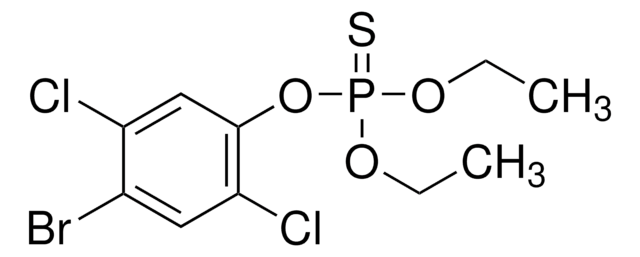PS100
Piperonylbutoxide
analytical standard
Synonym(s):
2-(2-Butoxyethoxy)ethyl (6-propylpiperonyl) ether, 4,5-Methylenedioxy-2-propylbenzyldiethyleneglycol butyl ether
About This Item
Recommended Products
grade
analytical standard
packaging
ampule of 100 mg
manufacturer/tradename
Chem Service, Inc. PS-100
technique(s)
HPLC: suitable
gas chromatography (GC): suitable
refractive index
n20/D 1.498 (lit.)
bp
155 °C/0.3 mmHg (lit.)
density
1.059 g/mL at 25 °C (lit.)
application(s)
agriculture
environmental
format
neat
SMILES string
CCCCOCCOCCOCc1cc2OCOc2cc1CCC
InChI
1S/C19H30O5/c1-3-5-7-20-8-9-21-10-11-22-14-17-13-19-18(23-15-24-19)12-16(17)6-4-2/h12-13H,3-11,14-15H2,1-2H3
InChI key
FIPWRIJSWJWJAI-UHFFFAOYSA-N
Looking for similar products? Visit Product Comparison Guide
Application
Signal Word
Warning
Hazard Statements
Precautionary Statements
Hazard Classifications
Aquatic Acute 1 - Aquatic Chronic 1 - Eye Irrit. 2 - STOT SE 3
Target Organs
Respiratory system
Supplementary Hazards
Storage Class Code
10 - Combustible liquids
WGK
WGK 3
Flash Point(F)
339.8 °F - closed cup
Flash Point(C)
171 °C - closed cup
Personal Protective Equipment
Choose from one of the most recent versions:
Certificates of Analysis (COA)
It looks like we've run into a problem, but you can still download Certificates of Analysis from our Documents section.
If you need assistance, please contact Customer Support.
Already Own This Product?
Find documentation for the products that you have recently purchased in the Document Library.
Our team of scientists has experience in all areas of research including Life Science, Material Science, Chemical Synthesis, Chromatography, Analytical and many others.
Contact Technical Service










